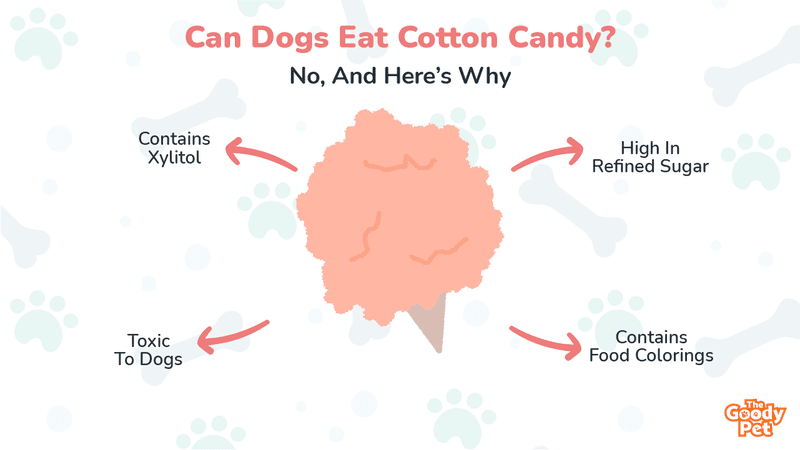Cotton candy is a popular and tasty snack for humans. And dog parents are often left feeling confused on whether or not it’ll make a good treat for their canine buddies, especially when those sad, imploring eyes come into play. So, can dogs eat cotton candy?
No, dogs cannot eat cotton candy because it is not safe. Cotton candy typically contains ingredients that, if consumed by a dog, even in the smallest amounts, can be extremely harmful to the dog’s health.
What then are these cotton candy ingredients, and in what way do they impact negatively on canine health? Answers to these questions are contained in this article. If your canine buddy also mistakenly chews on a piece of cotton candy, don’t panic! We’ve included a handy guide on what to do if your dog eats cotton candy in the article. However, before we go into all this, let’s have a closer look at what makes cotton candy dangerous for dogs.
Can Dogs Eat Cotton Candy?

The answer to this is simple – No, dogs can’t eat cotton candy due to the nature of the ingredients used in formulating this food product.
Typically, and as the name suggests, cotton candy is prepared by mixing together:
- An unhealthy amount of refined sugar
- Artificial sweeteners such as xylitol
- Food coloring to make it visually appealing to dogs
That said, refined white sugar makes up the majority of cotton candies and is pretty much what your pooch consumes when fed with this product. Consuming such an unhealthy amount of sugar can lead to issues with your dog’s blood sugar level, vomiting, and breathing difficulties, just to mention a few.
Additionally, dogs easily get addicted to sugar, and having your canine buddy always seeking out the candies isn’t a pleasant situation to have to deal with.
While it can be argued that dogs, similar to humans, need sugar to carry out metabolic activities, sugar for dogs can always be gotten via natural, healthier means.
Xylitol is considered safe for humans to eat, but for dogs, it is another story entirely. It has been established that xylitol becomes harmful to a dog when consumed in amounts equal to or higher than 100 mg per 2 lbs of body weight; plus, what this means is that an 80-pounder dog will be in serious trouble while consuming 4 g of xylitol!
When consumed in these small amounts, xylitol can induce seizures, lethargy, and even coma in dogs! And the aforementioned symptoms are similar to what food coloring chemicals can cause in dogs.
What Are The Side Effects Of Feeding A Dog With Cotton Candy?

Possible side effects of feeding a dog with cotton candy include a high blood sugar level, stomach issues, weight-related problems such as obesity, and tooth decay.
We’ve mentioned before how cotton candy isn’t safe for dogs to feed on, and outlined below are some of the possible health complications that your pooch may likely suffer from if you insist on feeding it with cotton candy:
Blood Sugar Level Imbalances
As mentioned earlier, cotton candy typically incorporates xylitol as the main ingredient, and xylitol is responsible for an increase in a dog’s insulin levels, thereby resulting in a corresponding drop in sugar levels.
And in a similar fashion, the high sugar content of cotton candy can result in a dog’s blood sugar level becoming astronomically high.
These random spikes and drops in your dog’s blood sugar levels, caused by feeding the dog with cotton candy, can lead to a host of additional side effects such as:
- A loss of appetite
- Extreme weakness
- Loss of body coordination
- Skin and gum discoloration
- Seizures
Stomach Upset
The bacteria contained in a dog’s gut can only properly digest a certain amount of sugar at a time. Hence, when the pooch’s stomach is suddenly loaded with sugar from eating cotton candy, an imbalance is created, thereby resulting in gastrointestinal issues such as diarrhea and vomiting.
Dental Issues
It is a well-known fact that too much sugar is harmful to human teeth, and this holds true for dogs as well. Cotton candy contains a significant amount of sugar which typically produces an ideal environment for bacteria to thrive. That said, regular consumption of this food product can result in issues such as tooth decay and tartar build-up for your dog.
Weight-Related Issues
Regularly ingesting sugar contained in cotton candy can also lead to a host of weight-related problems for dogs, such as obesity, which can, in turn, result in a pooch developing diabetes. The aforementioned medical conditions are quite dangerous to dogs, and, if left unchecked, can possibly claim a dog’s life.
Toxic Poisoning
There are times when cotton candy contains chocolate, and when consumed by your dog, this spells impending doom for your canine buddy.
Chocolate contains an active ingredient known as theobromine, and dogs often experience difficulties digesting this food ingredient. That said, theobromine in a dog’s body system comes with a host of medical issues such as:
- Increased heart rate
- Excessive panting
- Vomiting
- Seizures
- Muscle tremors
- Heart failure and death
What Should I Do If My Dog Eats Cotton Candy?

The first thing to do if your dog eats cotton candy is to call your vet for advice, after which you should proceed according to instructions provided by the vet.
Call A Vet
If you notice that your dog has eaten cotton candy containing xylitol, no matter how little, the next point of action is to immediately place a call explaining the situation to a vet.
Typically, the vet will require that you provide information regarding the dog’s breed, size, and how much of the cotton candy the pooch was able to gobble down. And it is the information provided that will assist your vet in determining the next course of action.
If your dog has licked just a small amount of cotton candy produced with refined sugar, such a dog will most likely be fine, but you should still watch for signs of food poisoning in such a dog. Do not try to physically induce vomiting in the dog unless the vet specifically advises you to do so.
On the other hand, if your dog licks or gobbles down cotton candy containing xylitol, immediate medical attention is needed to ensure your fido’s safety. If xylitol remains in a pooch’s body beyond thirty minutes, the dog’s body will absorb the xylitol, and you may begin to observe symptoms of xylitol consumption in such a dog.





